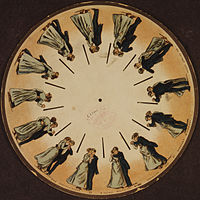Monday 31 May 2010
Early animation..
Zoetrope (180 AD; 1834)
The zoetrope is a device which creates the image of a moving picture. The earliest elementary zoetrope was created in China around 180 AD by the prolific inventor Ting Huan (丁緩). Made from translucent paper or mica panels, Huan hung the device over a lamp. The rising air turned vanes at the top from which hung the pictures painted on the panels would appear to move if the device is spun at the right speed.
The modern zoetrope was produced in 1834 by William George Horner. The device is essentially a cylinder with vertical slits around the sides. Around the inside edge of the cylinder there are a series of pictures on the opposite side to the slits. As the cylinder is spun, the user then looks through the slits to view the illusion of motion. The zoetrope is still being used in animation courses to illustrate early concepts of animation.
The magic lantern
The magic lantern is the predecessor of the modern day projector. It consisted of a translucent oil painting and a simple lamp. When put together in a darkened room, the image would appear larger on a flat surface. Athanasius Kircher spoke about this originating from China in the 16th century. Some slides for the lanterns contained parts that could be mechanically actuated to present limited movement on the screen.
Thaumatrope (1824)
A thaumatrope was a simple toy used in the Victorian era. A thaumatrope is a small circular disk or card with two different pictures on each side that was attached to a piece of string or a pair of strings running through the centre. When the string is twirled quickly between the fingers, the two pictures appear to combine into a single image. The thaumatrope demonstrates the Phi phenomenon, the brain's ability to persistently perceive an image. Its invention is variously credited to Charles Babbage, Peter Roget, or John Ayrton Paris, but Paris is known to have used one to illustrate the Phi phenomenon in 1824 to the Royal College of Physicians.
Phenakistoscope (1831)
The phenakistoscope was an early animation device, the predecessor of the zoetrope. It was invented in 1831 simultaneously by the Belgian Joseph Plateau and the Austrian Simon von Stampfer.
Flip book (1868)
The first flip book was patented in 1868 by a John Barnes Linnet. Flip books were yet another development that brought us closer to modern animation. Like the Zoetrope, the Flip Book creates the illusion of motion. A set of sequential pictures flipped at a high speed creates this effect. TheMutoscope (1894) is basically a flip book in a box with a crank handle to flip the pages.
Praxinoscope (1877)
The praxinoscope, invented by French scientist Charles-Émile Reynaud, was a more sophisticated version of the zoetrope. It used the same basic mechanism of a strip of images placed on the inside of a spinning cylinder, but instead of viewing it through slits, it was viewed in a series of small, stationary mirrors around the inside of the cylinder, so that the animation would stay in place, and provide a clearer image and better quality. Reynaud also developed a larger version of the praxinoscope that could be projected onto a screen, called the Théâtre Optique.
History of Animation, Wikipedia, Accessed on 31/5/10, http://en.wikipedia.org/wiki/History_of_animation
